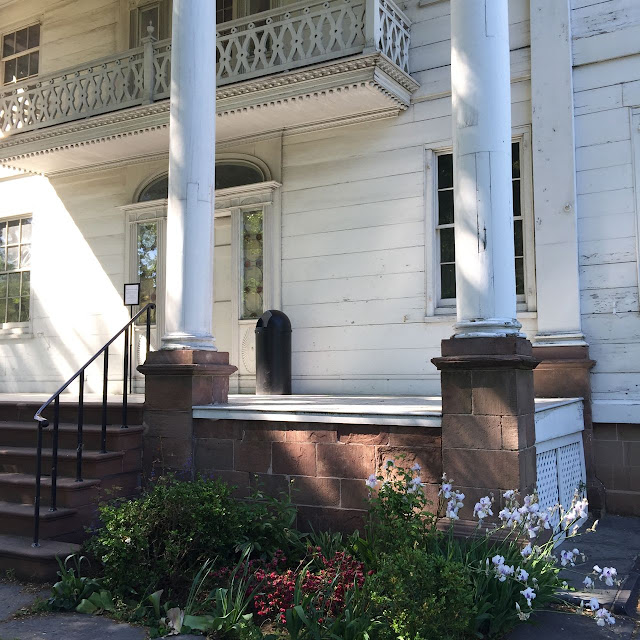Imagine a formal sit-down dinner during the colonial era in the dining parlor of a mansion. The mansion and its gardens sit high on a hill with long and deep views of rivers and a harbor. Inside, the host and his company conduct the busy work of a new government, promoting the economy and transforming fellow soldiers into enterprising citizens for peacetime. At the periphery of the table, servants and domestics attend to the guests' needs in hushed silences, disappearing when needed into the mansion's dark stairways and basements. Many were slaves.
 |
| exterior, Morris-Jumel Mansion. |
The year is 1790. The presiding host at the dinner table, President George Washington, has assembled his cabinet members at this mansion on a hill, including Thomas Jefferson, Alexander Hamilton, John Adams, James Madison, and Henry Knox.
 |
| Octagonal Drawing Room, Morris-Jumel Mansion |
President Washington knew the place well. What is now known as the Morris-Jumel Mansion in Washington Heights was originally built in 1765 by British Colonel Stephen Morris and his pedigreed wife, Mary Philipse, as their summer home. During the American Revolution, General Washington occupied the house for a time, and the property was eventually seized from the British following the conclusion of the conflict. The house is now 250 years old, New York's oldest house. The cabinet dinner party is 225 years old, and the dining room still looks fresh from dinner. You can see Washington's bedroom on the second floor. Also Aaron Burr's.
 |
| Aaron Burr's Bedchamber, 1833. Morris-Jumel Mansion. |
The history of the house and its inhabitants is beyond socially intricate. The Morris-Jumel Mansion's most notorious resident, Eliza Jumel, acquired the house in 1804 with her French emigre husband Stephen Jumel, and after husband turned up dead in 1832 - mysterious circumstances, of course, Eliza married up to ex-Vice-President Aaron Burr, who as we know killed the aforementioned dinner guest Alexander Hamilton in a famous duel decades earlier. Even in daylight, the house feels haunted, especially by Eliza. As told, she's an ambitious gold digger padding her resumé with Napoleonic and Empire accents, a pretentious parvenu who drops a lot of names. In time, she may warrant a new biography.
 |
| The Ghost of Eliza Jumel, Yinka Shonibare MBE. Morris-Jumel Mansion. |
If you want to make a day of it in Northern Manhattan, consider strolling south about twenty-five blocks or so to
Alexander Hamilton's house, La Grange. We don't think enough about the area's rich colonial history, but that may be changing. The new hit musical
Hamilton, with music and book by Lin Manuel-Miranda, invites a revisionist look at the Founders as well as heightens awareness of colonial history "in the Heights." The playwright grew up in these parts and spent some serious writing time in the Morris-Jumel Mansion.
 |
| Girl on Scooter, 2009. Yonka Shonibare MBE. Fiberglass mannequin, Dutch wax printed cotton, Leather, and wood. Mary Bowen's Bedchamber. Morris-Jumel Mansion. |
This summer, a visit to the Morris-Jumel Mansion is immeasurably enhanced by the extraordinary art of Yinka Shonibare MBE, an English national of Nigerian heritage. His work explores colonialism via figurative sculptures often clothed in Dutch wax fabrics and meant to signify the multicultural presence of the humans traded and bartered in the transatlantic mercantile trade of the 18th and 19th centuries.
 |
| Planets In My Head, Arts, 2011. Yinka Shonibare MBE. Fiberglass mannequin, Dutch wax printed cotton, Fiberglass globe, violin, and leather. |
Sculptures from one of the artist's 2009 series on children are installed in the rooms, young people engaged in the playful gestures of childhood. Yet, they are headless, bereft of a known presence in written history. In addition, for this exhibition, Shonibare has created a site-specific installation for the Front Parlor, a ghost mirror that conjures the specter of Eliza Jumel herself.
One of the fascinating aspects of the New York tourist trade is the ever shifting foci of historical interest. In earlier times, for example, the uptown sites of Grant's Tomb and Audubon Terrace drew large crowds of interested visitors. Maybe the geographical coordinates will shift once again. We are always seeking out the ghost mirror of our time.
 |
| Honeysuckle on the grounds of the Morris-Jumel Mansion. |
___
Directions: By subway, take the C to 163 St - Amsterdam Av. Walk south on Saint Nicholas Ave just past the C-Town Supermarket. Look for the stairs leading up to Sylvan Terrace, an extraordinary enclave of wooden houses lining a cobblestone street, a fairytale in broad daylight. Walk up Sylvan Terrace to the Morris-Jumel House. After the visit, be sure to take time to see more of the Jumel Terrace Historic District.
 |
| Sylvan Terrace, with Morris-Jumel Mansion at the end of the street. |
The Morris-Jumel Mansion is located in Roger Morris Park, 65 Jumel Terrace. Map below.
Website
Yinka Shonibare MBE: Colonial Arrangements continues through August 31, 2015.
Images by Walking Off the Big Apple from May 23, 2015.













Comments
Post a Comment